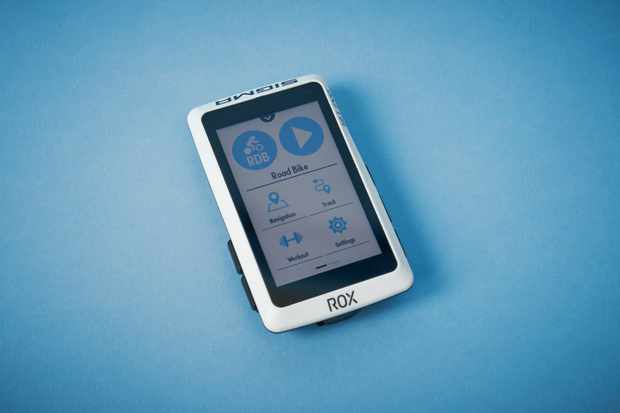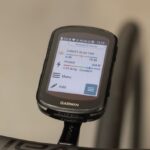The Sigma ROX 12.1 Evo became the German brand’s premium GPS computer when it launched earlier this year.
Advertisement MPU reviews
But despite costing a hefty €379.95 / $379.95 / €379.95, the Sigma ROX 12.1 Evo lags behind its mid-market rivals and even cheaper models. Poor battery life and missing features that are common on computers of the same price also hold it back.
Table des matières
Sigma ROX 12.1 Evo specifications and details

Steve Sayers / Our Media
Inside overall dimensions of 95mm tall, 57mm wide and 21mm deep, the Sigma ROX 12.1 Evo has a 76mm (three inch) wide touchscreen.
Two plastic buttons on the left and three on the right are also used to control the computer.
Its size is similar and its 240×400 pixel resolution identical to the Wahoo Elemnt Roam V2, but the screen is less crisp than the Hammerhead Karoo 2’s 480×800 pixels.
The Sigma ROX 12.1 Evo uses a Garmin-style quarter-turn fitting. An out-front mount, stem mount, lanyard and USB-C charging cable come in the box.
The addition of Bluetooth to ANT+ connectivity allows you to sync to your phone without a WiFi connection.
All the usual sensors, from electronic groupsets to electric bike motors, are compatible with the computer.
Mapping and navigation

Steve Sayers / Our Media
For mapping and navigation, the Sigma ROX 12.1 Evo uses multi-band signals from GPS, Glonass and Galileo satellites.
This is short of multi-GNSS – the gold standard in accuracy terms for bike computers.
This is a notable omission on a €379.95 computer.
The Garmin Edge 540 has multi-GNSS at a lower price (€349.99/$349/€399.99/AU$599).
But Sigma ROX 12.1 Evo operates from the same OpenStreetMap database as its competitors.
Unlike the cheaper Sigma ROX 11.1 Evo, the ROX 12.1 gives turn-by-turn directions.
Iffy build

Steve Sayers / Our Media
Sigma says the ROX 12.1 Evo is its first bike computer to be made in Germany. But it doesn’t hit the build quality standards you’d expect from German engineering.
Although I didn’t notice the effect of water infiltrating the device, the rubber cover for the USB-C charging port is reluctant to stick down.
The charging cable supplied in the box is annoyingly short. While charging, this means the computer has to sit right next to the socket or dangle in mid-air.
I soon found the Rox 12.1 Evo’s shrill alert tones (for example, on/off, stop/start) grating.
Reminiscent of a nineties Nintendo, the tinny bleeps accentuate the cheap impression given off.
Sluggish set-up but easier customisation

Steve Sayers / Our Media
Sigma may have signed up Marcel Kittel as a brand ambassador, but the ROX 12.1 Evo is slow off the mark, taking up to a minute to turn on.
In comparison, I’ve timed the Wahoo Elemnt Roam V2 start-up time at 35 seconds. The (admittedly much more expensive) Garmin Edge 1040 Solar is practically immediate.
Such performance issues give the impression that the cycling computer’s processor could do with some of the German sprinter’s power output, even in retirement.
That said, the accompanying Sigma Ride app has similar features to Wahoo Elemnt and Garmin Connect: device setting adjustment, route previews, and activity analysis, for example.

Steve Sayers / Our Media
The ROX 12.1 Evo has six predefined (for example, road, gravel and mountain bike) and 22 customisable ride profiles.
Many Garmin devices have this function but none of Wahoo’s computers do.
It’s fortunate the Sigma Ride app works well. The small-sized touchscreen, which is sometimes under- and other times over-responsive, makes it fiddly to alter settings directly on the computer.
I liked that on the map screen you can position data fields above as well as below the map. To me, this makes them easier to read while riding.
Sigma ROX 12.1 Evo performance
Navigation

Steve Sayers / Our Media
Sigma says you can ‘draw’ routes on the ROX 12.1 Evo touchscreen.
The Draw my Route mode is supposed to enable you to connect points on the map by drawing a line between them with your fingertip.
The ROX 12.1 Evo is then claimed to create a route by moving the line onto the nearest suitable road or trail.
My inability to do so owed to a combination of the screen’s lack of accuracy and responsiveness and my insufficient dexterity and patience.
Fortunately, the integration with route-planning apps like Komoot is smooth. I found routes synced promptly with the Sigma Ride app.
From there you have to favourite or manually upload them to the computer. They don’t sync automatically as I initially expected.
The ease with which you can follow routes on the Sigma ROX 12.1 Evo is its strongest suit.
A red arrow demarcates your position on the road or trail.
Ahead of a junction, a distance-to-turn warning pops up, the screen zooms in and the red arrow moves ahead down the turn you should take.
This helped me better visualise the way I needed to go, particularly when navigating off-road.
Re-routing back to a loaded route worked okay – if it can find another way, the Sigma ROX 12.1 Evo doesn’t always suggest you rejoin the course where you left it.
But navigating to the start of a route proved more problematic when the start and finish were close together (as is typical for loops).
After a round-trip route, the Sigma ROX 12.1 Evo sometimes said I had 250m to go and kept sending me back to the end.
I knew the way so I continued, ended the navigation and reloaded the route further away from the finish. This did work.
Sigma touts how the Sigma ROX 12.1 Evo offers three route options to a destination (suggested, easiest and shortest) taking account of the activity profile you’re in.
Whether on tarmac on dirt, its routing suggestions turned out to be sensible.
Whimsical explorers might enjoy this feature on a bikepacking trip where every day isn’t meticulously planned.
But I either navigate with my nose or follow a pre-loaded route, so I didn’t find these multiple routing options useful.
Lack of smart and safety features

Steve Sayers / Our Media
Live tracking has been standard on the best bike computers for a number of years.
A climber feature, which detects upcoming climbs whether or not you’re following a route, is a more recent addition.
While they are not universally popular, the omission of both features puts the Sigma ROX 12.1 Evo well behind the pack.
It’s more expensive than Wahoo’s bike computers, the Elemnt Bolt V2 and Elemnt Roam V2, which both have these features.
To its credit, the ROX 12.1 Evo does have Crash Detection, which I didn’t have the misfortune to put to use.
Temperamental touchscreen

Steve Sayers / Our Media
To varying degrees, bike computer touch screens do not work well in the rain. But the Sigma ROX 12.1 Evo’s performance under precipitation is dismal.
A mere patter of droplets on the touchscreen sends the device skipping through pages with the agility and unpredictability of a young Muhammed Ali.
Like Sonny Liston on Miami Beach in 1964, I was left chasing shadows in one moderate shower.
Water falling on the touchscreen altered the data fields of the activity profile I was using before I could lock the screen.
From then on, I locked the screen at the hint of rain. Being stuck on one screen curtails the functionality of the device.
Oversensitive buttons
The side buttons are oversensitive, so I regularly turned on the computer by accident when brushing past them.
While riding (without gloves) I often knocked the wrong button.
I haven’t encountered a similar issue with the side buttons of the Wahoo Elemnt Bolt or Roam. These buttons require more pressure to activate.
Insipid battery life

Steve Sayers / Our Media
Senior technical editor Warren Rossiter flagged battery life issues when he reviewed the Sigma ROX 12.0 Sport.
Instead of being resolved, these appear to have been exacerbated on its successor.
Sigma’s claimed 14 hours of normal usage bears no resemblance to the reality of my testing.
I was lucky to get half of this while running a power meter and heart rate monitor.
I managed a still disappointing 10 hours with just a heart rate monitor connected.
By contrast, in our testing, the Wahoo Elemnt Roam V2 comes close to its claimed 17-hour battery life.
Curiously, Sigma says the Rox 12.1 Evo has a 2,400 mAh battery, which is larger than the Roam’s 2,000mAh.
While navigating on top of running sensors, one full charge of the Sigma Rox 12.1 Evo lasted a mere 4.5 hours.
Such poor stamina undermines the Sigma’s navigational performance. You can hardly trust it to last for a long ride, let alone a multi-day trip.
Training data

Steve Sayers / Our Media
The Sigma ROX 12.1 Evo fairs better for training. It comes with preloaded workouts or you can upload your own.
From basics such as speed, distance and time to advanced power meter metrics, such as Intensity Factor, it records everything you’d want (or perhaps could do without).
One such metric is the Sigma Performance Index (SPI). The Sigma Ride app applies this “objective measure of cycling performance” to each ride: an SPI of less than 100 is very low; over 600 is very high.
Anyone who knows how to train with power will be more familiar with Training Stress Score, a way to compare sessions and track training load. So Sigma’s own metric seems superfluous to me.
Although the value of AI-estimated performance metrics is questionable, the Sigma Ride app doesn’t auto-calculate your Functional Threshold Power or VO2 Max like some Garmin devices do.

Fotojet / Sigma Sport
Sigma has clearly put work into the Ride app, where you can analyse your ride’s speed, power data and much more.
But I’d argue this effort should have been invested elsewhere.
As Liam Cahill noted in a recent Garmin Edge 840 Solar review, most people will turn to cycling apps such as Strava or TrainingPeaks for post-ride geekery.
Sigma ROX 12.1 Evo bottom line
I have very few grounds on which to recommend the Sigma ROX 12.1 Evo.
The low-quality buttons and touchscreen do not befit its mid-range price. Nor has Sigma kept pace with recent improvements in bike computer tech.
Feeble battery life is a major limitation. You can’t capitalise on its easy-to-follow navigation or breadth and detail of training data.
Advertisement MPU reviews
Cheaper bike computers will perform as well if not better. You can get superior performance from Wahoo, Garmin and Hammerhead at or around the same price.







